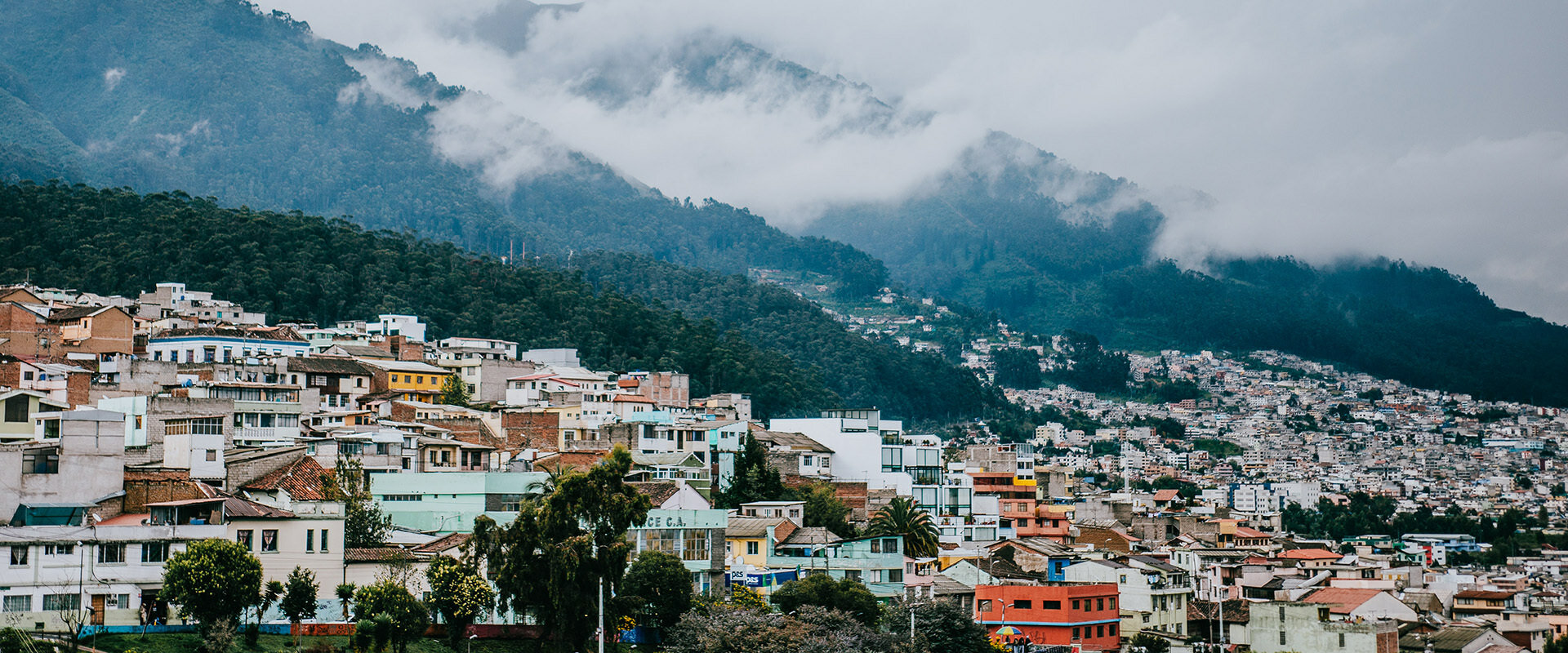With the rise of remote work, it’s time to embrace digital nomadism
There’s a stretch of road on the parched coast of Ecuador that hugs the shore so closely that as you drive, you can basically taste the salty Pacific. On the left-hand side, little wooden cabanas stand side-by-side, advertising the best of this South American country’s beachy eats: ceviche, crunchy shrimp, fried fish and cold pilsners sweating under the coastal sun. On a typical road trip down from the mountains, this is where your anticipation for the beach trip ahead reaches its peak: after hours and many geographical shifts, you’re almost there. This was the exact spot when, ahead of a long-weekend trip a while ago, my friends and I quickly debriefed. “Who is working this weekend? What times do you have to work? What’s your morning shift?”
By now, the friends I’ve made in Ecuador (I’ve lived here for two-and-a-half years) are all like me: laptop-toting “digital nomads” who work for companies or clients in the U.S., Canada, China and Korea. We’re teachers, editors, virtual assistants and writers. No one’s employment is tied to a physical location, and so it’s par for the course that on a weekend getaway, at least a few of us have work commitments. Honouring those requires double checking wifi access ahead of time, making sure there’s private space to work and setting the day up for success on the days where an assignment or class is on the schedule (read: waking up two hours before your friends do or sneaking away for a quiet afternoon in front of your screen.)

Working from the beach is definitely not my norm (I can’t give my self-discipline THAT much credit), but I have cracked open my laptop in Colombian kitchens, in coffee region hostels, in the Amazon jungle, in cafés in the middle of UNESCO-designated neighbourhoods and of course on breezy, seaside getaways. Working from these places usually takes all the willpower one can muster. It’s also, in my case, a priceless and infinitely worthwhile way to live and travel. And considering the traditional way of working for a lot of us just got a massive shake-up, I think this work-from-wherever lifestyle is also about to be way more attainable for more people than ever before.
We’ve become masters in the art of making it work. And I don’t think we’re going to be inclined to try to stuff the toothpaste back into the tube.
Now, as offices world-wide have shuttered for the past year and boardroom meetings have been swapped for virtual Zoom check-ins, our classic 9-to-5 in-person roles have been forced into a rethink. The remote worker isn’t just the Bali-based Instagram-famous blogger, it’s… most of us. And it doesn’t surprise me that a lot of us have discovered that not only does it work well, we kinda thrive like this.
We’re now working to get vaccines into arms and in doing so, beginning to envision a post-pandemic world. After a year-and-counting of hunkering down, our work lives have undeniably changed. We’ve been forced to operate in virtual spaces, and bosses have had to come up with outside-the-box solutions offering workers more flexibility than ever before. In the past, a remote-working staff could have easily been dismissed by company CEOs. No Monday roundtable check-in? How would we do presentations? No in-person accountability? It’ll never work! If I can’t see you not on Facebook all day, how do I know you’re not on Facebook all day? Now though, such fob-offs won’t suffice; we’ve become masters in the art of making it work. And I don’t think we’re going to be inclined to try to stuff the toothpaste back into the tube. Which leads me to say: if you’ve longed to pack your bags and try out the remote working lifestyle, your time could very well be approaching.
Let’s pause for a minute here to acknowledge that I’m talking about travelling only when and where it’s safe to do so. I’m not (I repeat NOT) encouraging anyone to pack a backpack, cross a border to a foreign country and put its citizens at risk. To do so is selfish, ignorant and in complete disregard to problems and risks faced by local communities. Ignorance abroad is a bad look. When you’re a guest, enter with grace. No excuses

Travel is not the opposite of work
When I look at what’s happening back home, I see that what has kept people in certain spots is their jobs. When your employment is tied to a physical location and the year affords you no more than two or three weeks to wander, that’s not a huge amount of wiggle room. With this switch to the virtual workspace though, Toronto has seen a record population loss with more than 50,000 people exiting to set up shop elsewhere. Currently, that’s looking like a shift to neighbouring regions. But does this statistic foreshadow a future in which workers finally have leeway to try a lifestyle away from home base? I think so. I think too of a recent call home to Canada where my brother listed the friends who had decided to plant their home office in more picturesque parts of Canada. “They decided to learn cross-country skiing in BC on their off hours,” he said. Honestly, good call.
Introducing part-time digital nomadism
It doesn’t have to be a permanent relocation, though. Digital nomadism or remote work tends to have people thinking of the stereotypical travellers who quit their jobs, sell all their stuff and go. For good. But it doesn’t have to happen that way, does it? Why not try it out for a short period of time, or just start to think about travel as not being the opposite of work? No expectations. In fact, there’s so many places within Canadian borders worthy of exploration that offer an incredible work-life balance. (Personally, the mountains in BC get my vote!) And when international travel re-opens, consider actually maxing out the length of your tourist visa when you travel to new countries. In the past, a more rigid separation between work and travel had most people unable to even consider visiting a place for more than three weeks at a time. But as many companies have already shifted to “permanently remote” arrangements, planning to stay put for the duration of a three-month tourist visa (a common length of time afforded to Canadians in many countries) could be a great way to dip your toes into the work-from-abroad lifestyle. (Note: visa regulations vary from country to country so, do the research to confirm the length, rules and restrictions of wherever it is that you’re considering going. Duh.)
Lots of countries and regions have perked their ears up as the world’s fleet of remote workers grows. Croatia, Estonia, Dubai, Iceland and lots more countries have introduced visas that appeal to digital nomads—which tend to fall somewhere between a tourist visa and a working holiday visa (the latter of which have age limitations). Often these are valid for up to a year and require some proof of work and accommodation, but allow you to stay a little longer while supporting yourself with work from outside the country. Here in Canada, Nova Scotia is even making a push to attract remote workers who work best with a fresh sea breeze.

Let the negotiations begin
Of course, there’s the very real possibility that after vaccines become widely distributed, your company will ask employees to return to their desks, at the office, in person. At that point, it becomes a negotiator’s game. I mean, they already dealt with you working away from the office for a year and counting. How did you perform then? You’re both still here, aren’t you? You were already forced to make it work when circumstances were outside of the ordinary… so you both know it’s possible. As long as the wifi is solid, Zoom, Slack, Trello and good ol’ email are still as trusty as they have been during pandemic months. And in terms of productivity and performance, it really varies person-to-person on whether or not office life creates the environment where you do your best work. If the answer’s no, state your case! And know that there are so many more clients and companies who hear of remote working setups now and think “Pft! No biggie! Send me your pics! Maybe I’ll even visit.” I’m speaking from experience here.
Find yourself a hostel homebase
There was one week in particular at a hostel in Quito pre-pandemic, where I was meeting my deadlines from the comfort of a communal dining room table. I had just been in Colombia for a while and I had a week to kill before meeting up with some friends from home. I had deadline after deadline, interview after interview for a story I was working on for a tourism magazine. Every day started with breakfast with the backpacker community—some much-needed social time as the caffeine hit. Now, you might balk at the idea of working amongst other travellers. (Too many distractions. Background chatter? No thanks!) But here’s a little secret that I learned during that period: travellers are usually gone sightseeing after breakfast (or they’re taking a recharge day alone) and won’t be back until the evening. The space is almost always to yourself!
Planning to stay put for the duration of a three-month tourist visa could be a great way to dip your toes into the work-from-abroad lifestyle.
When they return, and your workday is done, you have a built-in community of friends to hit up the bar with for happy-hour beers. Plus, hostel staff can give you the scoop on which local activities to add to your calendar… and which ones to pass on. You’ll also get the restaurant recommendations to check out during a mid-day break. (Almost every afternoon, I took time to saunter through the historical centre of town, nipping into cafes for coffee and empanadas. What a pleasant way to recharge!) During that time, I reveled in the slow travel while also getting in quality afternoons of writing. When the backpackers returned, we headed to Bandito Brewery for IPAs, nachos and catch ups.
Many hostels are transforming their shared spaces to accommodate digital nomads who need a comfy and somewhat quiet place to work during the day. YHA Australia is also highlighting the many perks for digital nomads at its own hostels down under.
We’re living in a time when the status quo (when it comes to work) has been questioned from every angle. In the past, there was a hard line between work and travel. Now, the two are not so separate and if ever there was a time for them to blend, it’s now. Sometimes it makes me laugh how five years ago, it was all about the hustle. During coffee time breaks, I’d scroll social media bombarded with headlines shouting Hustle Harder, and Grow Your Side Hustle. Then, unsurprisingly, the words of the career blogs was “burnout.” (How to Know if You’re Burnt Out, Ways To Bounce Back from Burnout) Now, it’s all about self-care, life balance or—and here’s the big one—JOY. The remote worker life embodies each of those. I’d know: I’ve been doing it for three years.
By the way, remember that coastal weekend I told you about? I worked a little each day. Yeah, I may have missed a beach walk here and a couple hours of morning snoozing there, but I certainly got my fair share of salty margaritas and hours spent splashing in the waves. Not a bad way to make a living, eh?
Issue 4


